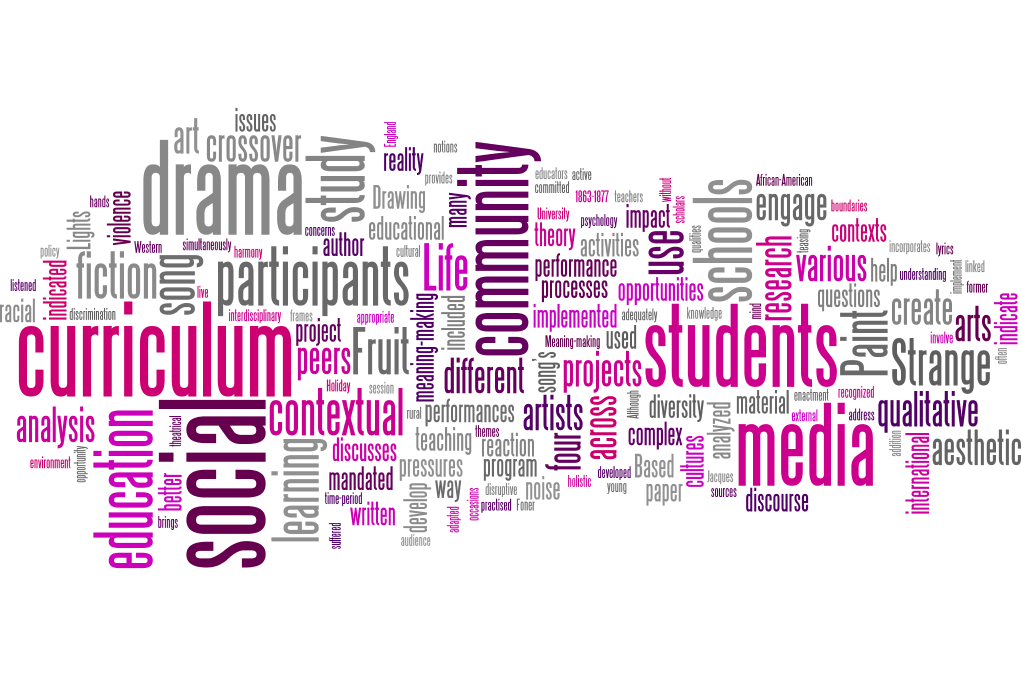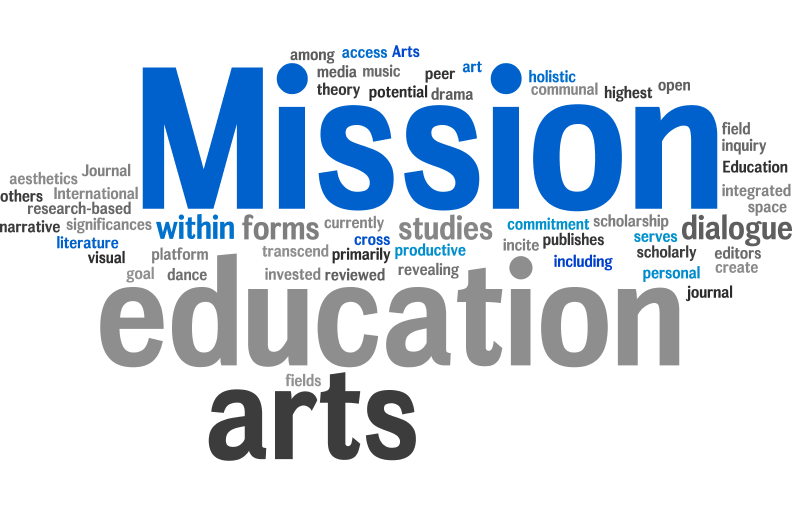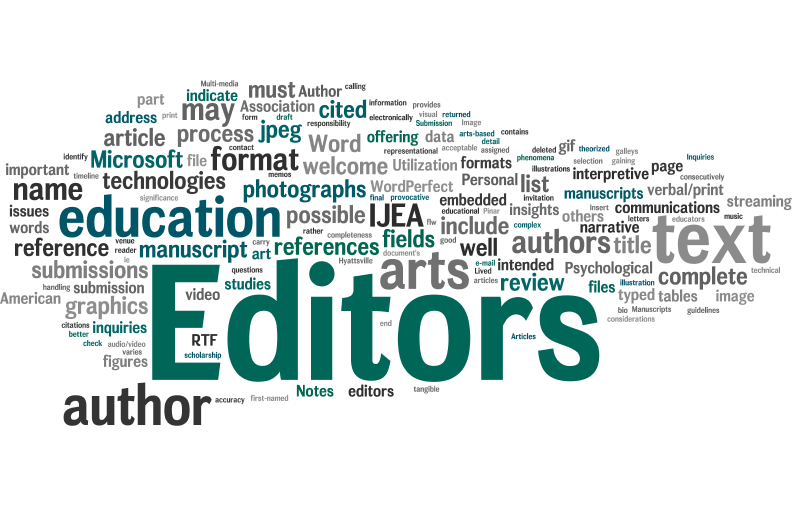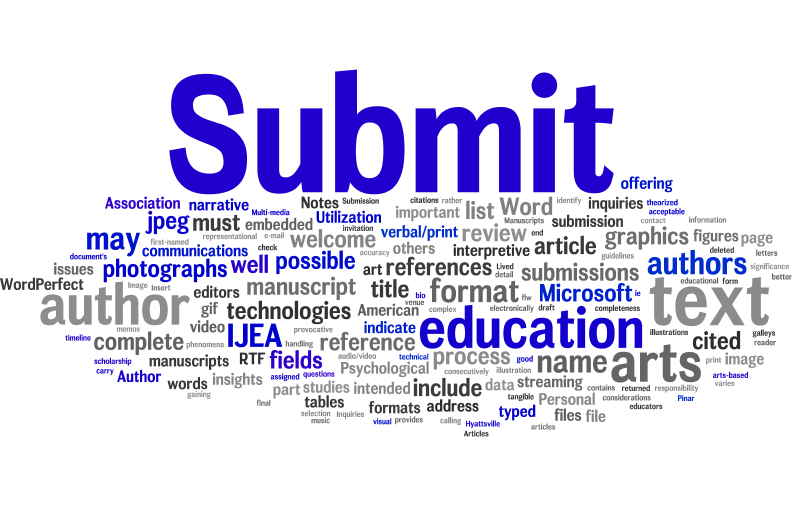2018 Volume 19
Articles and Abstracts

Articles
Volume 19 Number 1: Knudsen, K. N. (2018). Challenging fiction: Exploring meaning-making processes in the crossover between social media and drama in education.
The aim of this study was to explore how meaning-making activity can be expressed and shaped in the crossover between drama in education and social media. This study concerns the use of empirical material from an educational drama project called #iLive, which was designed and implemented, on four different occasions with a total of 89 students from upper secondary schools in Norway in autumn 2015. The results indicated that operating in the crossover between drama and social media was a way of challenging the aesthetic qualities of drama in education. For instance, it was found that the way in which social media simultaneously frames several platforms for social interaction and blurs the boundaries between fiction and reality was different from working with fiction in relation to the teaching and learning of drama. Meaning-making processes in educational drama often tend to mediate through the vehicle of fiction by asking questions like what is the play really about? Such challenges, and the fresh questions that were raised as part of the project, led me to the philosopher Jacques Rancière’s “aesthetic regime” (2004) and his notion of dissensus. In the analysis, I adapted his theory as a theoretical framework for the discussion of how social media can revitalise the teaching and learning of drama. Based on this, I suggest that meaning-making processes in the crossover between drama and social media can be described as transformative, in that they redistribute and re-negotiate fragments of fiction or reality, and involve border-crossing activities between the notions of art and non-art.
Volume 19 Number 2: Chapman, S., Wright, P. R., & Pascoe, R. (2017). “Content without context is noise: Looking for curriculum harmony in primary arts education in Western Australia.
Arts education in Western Australian primary schools consist of learning opportunities outlined by mandated curriculum. However, assumptions underlying this curriculum involving access, resources and support impact schools’ capacity to implement the curriculum without them being adequately addressed by the written curriculum. Drawing on the policy enactment theory of Ball, Maguire, and Braun (2012), four contextual variables (situated contexts, professional cultures, material contexts and external factors) are used to highlight the differences between the written published curriculum and the implemented, practised curriculum. Drawing on interviews with 24 participants across four schools issues of geographic location, use of arts specialists, appropriate learning spaces and the stresses associated with mandated literacy and numeracy testing are reported as contextual pressures by this study. This paper details the disruptive interference of these contextual pressures that we describe as ‘noise’. The provision of a better understanding of this contextual landscape brings schools and teachers away from the ‘noise’ of disruption and closer to curriculum harmony.
Volume 19 Number 3: Song, Y. I. K. (2018). Fostering culturally responsive schools: Student identity development in cross-cultural classrooms.
This research incorporates various projects to address issues of diversity in a rural Korean community with bicultural children. The interdisciplinary activities in the projects seek to help students better understand their interracial peers, accept diversity, and not engage in bullying and teasing behaviors. In addition, the social psychology projects attempt to help students develop a more open mind about each other’s cultures. It also discusses how educators may be able to develop a more comprehensive and holistic curriculum on the topic of cross-cultural education.
Volume 19 Number 4: Esteve-Faubel, J-M., Martin, T. J., & Junda, M. E. (2018). Cross-curricular teaching going forward: A view from “Strange Fruit”.
“Strange Fruit”, a song popularized by Billie Holiday in 1939, paints a gruesome picture of racial violence suffered by former African-American slaves following Reconstruction, 1863-1877 (Foner, 2011). While many scholars have analyzed the lyrics of “Strange Fruit”, research that focuses on young people’s reaction to the song is scarce. This study explores the impact of Holiday’s performance of the song on students at a New England Research University. Institutional survey software was used to create an online questionnaire that participants (n= 40) answered in a controlled environment. The findings indicate feelings of disgust, anger, shame and sadness after participants listened to “Strange Fruit”. Although few students could indicate the song’s time-period, many recognized the atrocities committed against African-Americans since slavery and the discrimination that continues. “Strange Fruit”, irrespective of whether the participants knew the background of the song, provokes a powerful reaction against racial violence, one which demonstrates the song’s value as a cross-curricular pedagogical tool for developing transversal competences linked to socially desirable values and principles.
Volume 19 Number 5: McDermott, M. (2018). Beyond words: Paint Your Life™—An international system for transforming how we think about ourselves and others.
This paper outlines an ongoing qualitative review of themes that have emerged across the various session of the Paint Your Life program which was developed over the last 15 years. The author discusses the potential for Paint Your Life to disrupt hegemonic discourse about art, artists, and community development. Based on the qualitative collected from across different international sessions the author suggests that Paint Your Life offers a radical means for re-imagining international education policies and art discourse, including the ways in which the arts, in the hands of various community groups can create “border crossing” between artists and non- artists, between school and community, between cultural distances, and between self and “Other.” The early research into this program anticipates how Paint Your Life might contribute to anti-oppressive aesthetic community projects.
Volume 19 Number 6: Casassa, K., Cappello, M., Bedau, D., & Cirino, P. (2018). Tweeting at Dr. Faustus: #sdsufaustus.
This qualitative study presents an analysis of how the use of social media can provide opportunities for students to critically analyze complex texts and collaborate with peers. The students participated as active audience members at a theatrical performance of Gertrude Stein’s Doctor Faustus Lights the Lights at a large urban university. The performances included student participation in a live Twitter feed. Data sources included observations of the performances and the collection of Tweets; these were analyzed using thematic analysis methods. Findings indicated that the use of social media provides participants the opportunity to engage in creative expression, co-construct knowledge with peers, create a sense of community, actively engage within the arts, and relate complex text to everyday life.
Volume 19 Number 7: Kallio, A. A., & Länsman, H. (2018). Sami re-imaginings of equality in/through extracurricular arts education in Finland.
The Indigenized arts-based inquiry reported in this article addresses matters of equality in Finland’s extracurricular arts education system, as experienced by Indigenous Sámi artists, arts educators, scholars, and community leaders. Challenging national narratives of cultural homogeneity and egalitarianism, this research identifies aspects of this publicly-funded arts education system that function to create, or perpetuate inequality for Sámi learners. Employing narrative and joik as analysis approaches, we reflect upon these processes of exclusion in order to envision new possibilities for this national arts education system to not only accommodate Sámi learners, but to learn from and together with Indigenous arts, pedagogies, onto-epistemologies and ways of being to enhance equality for all.
Volume 19 Number 8: Davis, S. (2018). The engagement tree: Arts-based pedagogies for environmental learning.
This case study reports on an arts-based project called “Tree-Mappa,” one that sought to engage primary-school children in learning about their local environment through significant trees. Pedagogical approaches featured the use of arts-based strategies as the means for activating cognitive and affective responses and learning. The frame for analysis was that of student engagement and learning, recognising that for students to be mobilised to care about and act for the environment requires both knowledge but also emotional commitment and the means for expression and communication. Findings drawn from student reflective responses and focus group interviews identified various triggers for student engagement. These included excursions and outdoor activities framed by arts-based processes. The study signals the value of ongoing research and practice to verify the potential of different arts-based strategies for engagement, commitment, and meaningful learning about the environment.
Volume 19 Number 9: Karppinen, S, Poutiainen, A., Kairavuori, S., Rusanen, S., & Komulainen, K. (2018). ImproStory: Social improvisation and storytelling in arts and skills subjects.
Our pedagogic developing project, ImproStory, addresses improvisation and storytelling. We study how these two concepts could be applied in arts and crafts education for both primary and Kindergarten (daycare) teachers. The majority of our data consists of digital questionnaires in basic arts and crafts studies of primary pre-service teachers (N=323). Additional data (portfolios) contain a group of Kindergarten and primary pre-service teachers with a focus in visual arts (N=8). All data were collected at the University of Helsinki (Finland) during the academic year 2014–2015. According to our study, pre-service teachers consider improvisation and storytelling to be beneficial skills. They see developing them as necessary and useful. Experimenting and learning the approach appear to strengthen pre-service teachers’ collaboration and allow them to build independence, trust, and self-confidence within arts and crafts education. In addition, improvisation and storytelling helps them to recognize their individual creative potential.
Volume 19 Number 10: Gray, C., Pascoe, R., Wright, P. (2018). “I felt that I could be whatever I wanted”: Pre-service drama teachers’ prior experiences and beliefs about teaching drama.
Pre-service drama teachers enter teacher training with established ideas and beliefs about teaching. These beliefs, based on experience, are informed by many hours spent in schools, and the pedagogies – both effective and ineffective – utilised by their teachers. This research explores the influence of some of these prior experiences on pre-service drama teachers’ beliefs about teaching drama, this being important in the way that not only shapes their practicum experiences, but also what will then influence their own teaching of drama. Individual interviews with four pre-service drama teachers revealed the complexity and dynamics of these participants’ lived experience with narrative portraits constructed as part of the process of inquiry. This process not only built on the ways that knowledge is constructed, and the beliefs and values that underscore these, but also how these are shared and made known. Three key beliefs emerged. First, drama both provides and creates a sense of belonging: belonging being key for students and integral to the work of drama teachers. Second, drama education can promote self-discovery and personal development, having therefore the potential to transform lives. Third, effective drama teachers are valued as hardworking, highly skilled professionals dedicated to bringing out their students’ potential. This paper emphasises the importance for pre-service drama teachers to be aware of how their beliefs and subjectivities both influence their own experiences, and consequently have influence over the ways they work with students in the drama space.
Volume 19 Number 11: Schlaack, N. & Simpson Steele, J. (2018). The collaborative residency project: The influence of co-teaching on professional development in arts integration.
Many classroom teachers turn to arts integration as a method for meeting multiple learning objectives but are less than prepared to do so. The Collaborative Residencyprogram offered classroom teachers an intensive course of study through collaborative work with teaching artists as they co-planned and co-taught arts integrated units together. Consistent with the literature, participants in this study experienced the educational advantages of teaching through the arts to help students gain, acquire, and construct understanding. The results of this study highlight the interdependence of classroom teachers’ personal beliefs, behaviors and their environment, as well as the need for better institutional support to provide classroom teachers a ground on which they can continue their arts integration endeavors.
Volume 19 Number 12: Li, D. (2018). Using issues-based art education to facilitate middle school students’ learning in racial issues.
Issues-based art education encourages students to express their perspectives on different social issues through art making. In this article, the author discusses racial issues with middle school students through contemporary artwork discussion and hands-on poster making. The difficulties that students encounter in their poster making session will be discussed. In the final section, the author offers suggestions about teaching an issues-based art class for other teachers.
Volume 19 Number 13: Campbell, C. (2018). In search of our beginnings: Locating ‘firstness’ in arts education in the service of advocacy.
Attention to sub-conscious and pre-conceptual cognition is often neglected in educational research and theory, which, through failing to adequately conceptualize the emergence of perceptual learning, often inadvertently privileges a narrow and disembodied approach that emphasizes ‘abstract symbolic processing’ at the expense of more sensory forms of knowing. I argue that Umberto Eco's (2000) notion of primary iconism — understood as the terminus a quo of the perceptual/semiotic process — can offer educational discourses some needed conceptual clarity in regards to better understanding the relationship between creativity and ‘arts-based’ learning, with ‘everyday’ acts of perception. By considering this ‘starting point of the emergence of learning’, I aim to bring renewed attention to two neglected aspects of educational scholarship, specifically: 1) the role of creative inference (or what Peirce called Abduction) in defamiliarizing our conventional processes and modes of schematization, and; 2) an expanded (educational) account of consciousness, beyond what is actual and material, that can also recognize “the reality of potentialities not yet actualized, as Firstness” (Stables and Semetsky, 2015, p. 24). I hope such considerations can help sensitize researchers and arts practitioners to the importance of “imagistic and non-verbal semiosis as primary constituents of learning” (Titone, 1994, p. 129). I will argue that, through this (edusemiotic) conceptual framework, educational researchers and practitioners might gain insight into aspects of learning often associated with imaginative or creative/artistic perception, that are not easily expressed through many theories of learning, and therefore this research is valuable for arts education research and advocacy.
Volume 19 Number 14: Gose, R. & Siemietkowski, G. (2018). A collaboration in care: Re-visioning teacher-student dialogue in dance education.
The following narrative recounts a collaborative reflective investigation into pedagogical care using a teacher-student dyad approach. Originating from the student’s inquiry that fulfilled her teacher’s assignment, the ensuing exploration investigates care from both teacher and student perspectives in the classroom and choreographic settings. This concept of care—while not without its challenges and complications—is essential for the development of a healthy dynamic of mutual respect and learning between teachers and students. Supported by Noddings’ ethic of care (Noddings, 2003; Warburton, 2004), the authors examine how a holistic approach fosters open communication between teacher and individual student, allowing a rich collaboration and re-examination of the traditional dance classroom. To reflect the unique dialogical process of this collaboration, the authors have fashioned sections of the paper into divergent formats such as dual narratives and reflective dialogues. learning, and therefore this research is valuable for arts education research and advocacy.
Volume 19 Number 15: Grant, C. (2018). Developing global citizenship in tertiary performing arts students through short-term mobility programs.
This article examines how short-term overseas mobility (study abroad) programs in the performing arts can foster global citizenship among undergraduate university students. It assesses outcomes from two programs led by different Australian universities: the first in 2015, involving six music and drama students for three weeks; and the second in 2016, involving five music students for ten days. Both cohorts travelled with the author to Cambodia, collaborating with local artists and non-government arts organisations on a range of musical and cultural activities. Drawing primarily on student focus group transcripts and student reflective journal entries, here I examine the extent to which these mobility programs may have contributed to fostering a sense of global citizenship in students. Analysis centres on three broad themes: students’ development of global awareness and understanding, including intercultural awareness and empathy; their growing awareness and understanding of themselves and their societies; and the cultivation of their sense of social responsibility, including an aspiration to contribute to local and global society in a meaningful way. I also raise some challenges and risks of mobility programs with respect to the goal of building global citizenship in students, such as reinforcement of stereotypes and power differentials.
Volume 19 Number 16: Li, D. (2018). Critical media literacy: A social semiotic analysis and multimodal discourse of corpocracy.
Facing a wide range of mass culture as part of everyday life, art teachers have a responsibility to foster students’ critical media literacy to analyze the meanings conveyed in visual images. I use activist artist Ron English’s art as an example to assist students in deconstructing meanings presented in product packaging. Social semiotics and multimodal discourse are suggested in facilitating these processes of deconstruction to address several controversial issues presented in the packaging. The ultimate goal of analyzing/deconstructing different visual culture can foster students’ critical media literacy and facilitate their active participation in a democratic society.
Volume 19 Number 17: Beck, D. (2018). Welcome to Gallery 5: An immersive digital art experience.
Unfortunately, many schools have suffered budget cuts, heeded employer and state demands for increased STEM education, and faced increased pressure to prepare the children in their care for high stakes standardized exams, making art as an academic discipline an afterthought. To help bridge this gap, the Crystal Bridges Museum of American Art, in Bentonville, Arkansas, partnered with Virtual Arkansas to author high-quality digital courses for public high school students in Arkansas. The course includes extensive use of Gallery 5, an immersive, 3D online experience in which students curated their own art collection. This paper provides qualitative analysis of a pilot study of one of the courses, Art Appreciation: The American Identity. Qualitative data was examined, considering themes that inductively emerged from data collected using interviews and a focus group. Finally, recommendations are presented that should lead to learning design improvements.
Volume 19 Number 18: Bourgault, R. (2018). Across the bridge: A story of community, sociality, and art education.
The article examines the planning, development, and outcome of an experiential learning project that brought together undergraduate studio art students and the workers of a power plant about to shut down. As one of the instructors for the project, I reflect on how our emergent pedagogical methods interfaced or conflicted with students interests, and plant employees.
Principles of phenomenological research inspired my early steps to the study. However, its operative conceptual framework follows the thoughts of socially engaged artists Suzanne Lacy (2010) and Pablo Helguera (2011), guiding an analysis of the relationships between students and workers with instructors as observer-participants. I investigate how these roles and relations developed through different modalities that ranged from familial sentiments to memorializing impulses, including the industrial conditions that inspired various sensual and aesthetic student responses. I argue that the production of artwork as autonomous objects, which constituted the self-evident outcome of this community-focused experience, contributed only a transactional materiality to the project, and that the relational exchanges from which transformative experiences originated, offered unrivaled creative possibilities.
Special Issue
Volume 19 Special Issue 1: Sunday, K. (Ed.). (2018). Special issue: The everydayness of Tina
1. The Everydayness of Tina: An Introduction—Kristine Sunday
2. Once a Year…—Pat Tarr
3. Tina Thompson: My Superhero—Marissa McClure
4. Entering the Cultural Milieus of Children’s Drawing: Complicated Proximities—Christopher M. Schulte
5. Art Education and Beyond: Drawing and Young Children in Early Childhood Education—Kristine Sunday
6. Drawing, Dialog, Rapunzels, Rain . . . Dialogic Exchanges in Children’s Drawing and the Work of Dr. Christine Thompson—Leslie Rech
7. A Lifetime with Children and the Subtle Subversion of Respecting the Child—Heather Kaplan
8. Not Those Seven Annoying Dwarfs – Again! Collective Creativity in Children’s Artistic Production—Marleena Mustola
9. Pedagogy of Care: Embodied Relationships of Teaching and Mentorship—Natalia Pilato
10. A Note of Thanks—Mary Wolf
11. Composing a Beautiful Life: Homage to Tina—Liora Bresler
Book Reviews
Volume 19 Review 1: Lucero. J. (2018). Be at home in the word: An artist’s take on art, artists, and pedagogy: Philosophy and the arts in education.
This is a good book. It should be archived in your collection and you should come back to it often. Actually, there’s no other way to be with it. You must come back to it repeatedly. You must read it sequentially sometimes and you should also read it from its last chapter to its introduction. Occasionally, read the chapters out of order; skim the table of contents and read according to your preferences and curiosity; or be counterintuitive and read the parts that contrast your taste, interests, and familiarity. Read the essays aloud when you’re alone and read them in silence with others. Underline and markup whatever resonates with you. Annotate the margins with your questions. Leave bookmarkers and sticky notes in it. Leave it on your bookshelf, nightstand, or in your bag—ignoring it for months while you busy yourself with the tasks of being grown-up alongside/with the world—then be surprised by the fact that it exists and you own it. Take photos of its pages. Draw in it. Lend it to others. Post about it. The book is now in paperback and reasonably priced for an academic book, so it can even be assigned as a class text. Use the excuse of “teaching through” the text to hear differing things that others might have to say about it. Have a creative response to the book through your art, your teaching, and the working out of your own philosophies. Put all the creative responses that this book triggers back into the world.
Volume 19 Review 2: Mota, G. (2018). A review essay: Paradigm War: Lessons learned from 19th century piano pedagogy.
Piano Pedagogy has been, as rightly pointed out at the beginning of the introduction of the book by Lia Laor, “the center of unparalleled critical dialogue and scholarly discourse in 19th century Europe” (p. xv). However, and to my knowledge, there are no publications that have attempted to systematically capitalize on the wide diversity of contributions through a both thorough and innovative approach made concrete through the presentation of one as clear as profound framework of analysis.




